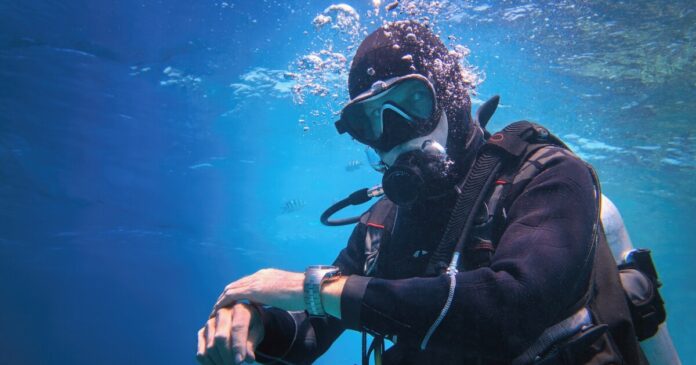Divers may soon be able to get a welcome boost to their flutter kicks thanks to an exoskeleton developed by researchers at Peking University (PU). By shouldering some of the burden of underwater swimming, the device could also make scuba tanks last longer.
Watching a diver glide through the water under the sea’s surface makes the activity look quite calm and gentle, but the process actually engages the largest muscle groups in the body – the legs. All of that muscle activation requires oxygen for fuel, which is provided by a diver’s tank. A diver using an 80-cubic-ft tank at a depth of 65.6 ft can expect that oxygen to last, on average, about 35-50 minutes.
In an effort to boost how much time a swimmer could stay under on one scuba tank, instead of focusing on breathing apparatus, the PU researchers took a novel approach: decreasing the energy expended while swimming and therefore oxygen needed by the diver.
The exoskeleton they created consists of multiple parts. There are two sealed motor units that mount to the diver’s back. These are connected to flexible Bowden cables that run down to lightweight cuffs on the diver’s thighs and shanks. A waist strap stabilizes the entire unit which mounts outside a diver’s wetsuit. The entire system weighs about 9 kg (20 lb), with most of the mass applied to the back of the diver.
Peking University
The real magic of the exoskeleton comes from the sensors embedded in the system called Inertial Measurement Units (IMUs), which transmit the position of the legs to the motor. This allows the motor to sense where in the flutter kick the legs are as the diver swims and adjust the force on the Bowden cables as needed. During the downstroke of the kick, thanks to a built-in clutch, the motor engages and assists the motion. For the upstroke, the motor is disengaged so that the system doesn’t fight the diver’s recovery motion.
To test the system, the researchers attached an exoskeleton to six certified divers who used it in a 50-meter (164-ft) swimming pool at a depth of two meters (6.6 ft). Each diver completed three 100-meter (328-ft) underwater swims using a flutter kick both with and without the exoskeleton and with it powered on and off. The test revealed impressive results, reducing quadriceps and calf activation by just over 20%, and decreasing air intake by 22.7%.
The researchers say more testing is needed to further refine the exoskeleton. They plan to use computational fluid dynamics to map water resistance on divers; test in more dynamic real-world conditions beyond the swimming pool; alter swimming speeds and styles; experiment with different lighter-weight materials; and apply more sensors that will monitor metrics like heart rate in addition to air consumption.
“Our research extends the application boundary of wearable robots and introduces a brand-new scenario for exoskeleton studies,” write the researchers in the study, which has been published in the journal, IEEE Transactions on Robotics. “Essentially, powered exoskeletons provide an enhancement of human functionality, and special environments or working conditions do not entirely diminish their utility.
“Our work provides a reference for the design and assessment of future underwater assistive devices, with the potential to strengthen the connection between humans and the ocean and to broaden the horizons of exploration.”
Source: Peking University


